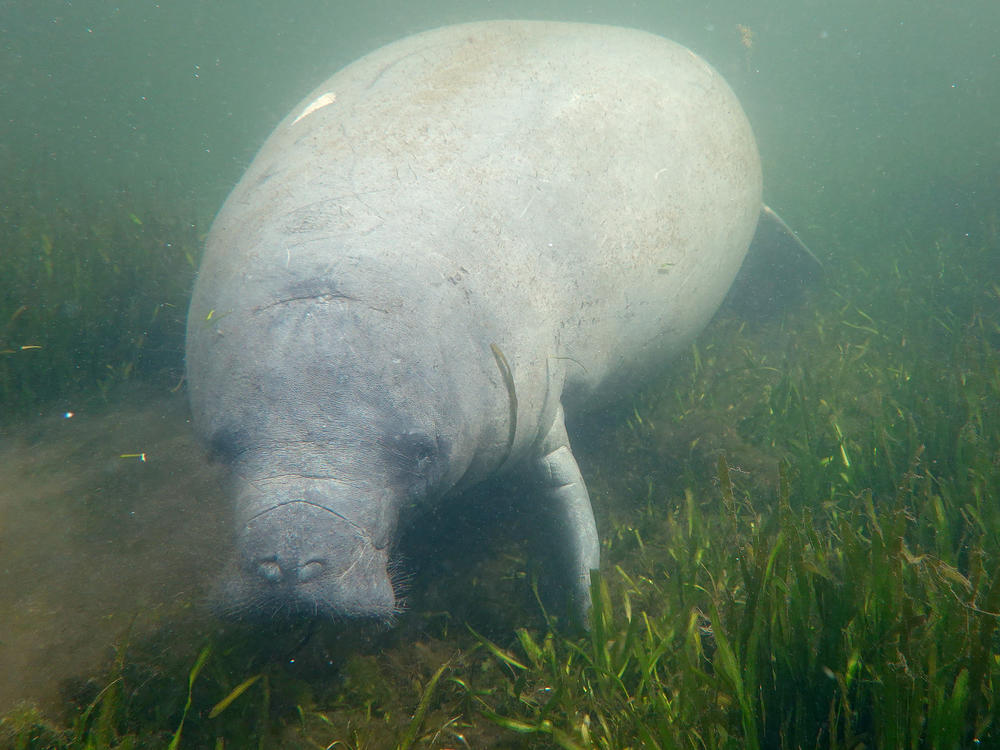Section Branding
Header Content
Manatees are starving in Florida. Wildlife agencies are scrambling to save them
Primary Content
In Florida, an ecological disaster has led to the deaths of more than 1,000 manatees. The large, slow-moving marine mammals graze on seagrass in shallow coastal areas, but a massive die-off of seagrass has left them without enough to eat.
The lack of food is most acute in Indian River Lagoon. That's a 150-mile-long saltwater estuary where more than 90% of the seagrass, the manatee's main food source, has died. The record number of manatee deaths this year is an estimated 10% of the total Florida population.
Manatees are susceptible to cold and congregate in the lagoon during winter. In the past, the main threats to them have been collisions with boats, toxic algae and cold weather.
This year, starvation became a major factor, leading the federal government to designate it an "unusual mortality event" and join with other wildlife agencies and conservation groups to respond.
Large numbers of starving manatees have been rescued, but Jon Peterson, who heads the rescue operation at SeaWorld Orlando, says rehabilitating an emaciated manatee is a slow process.
"You slowly stretch the stomach, get it used to food again," Peterson says. "A starvation event animal, we're looking at four to nine months before they're ready to go back out."
The large number of emaciated and distressed manatees is severely taxing a network of wildlife agencies, zoos and research groups that rehabilitate them and eventually reintroduce them into the wild. SeaWorld has expanded its rehabilitation facilities. Other aquariums and marine parks are also scrambling to add more water space.
Peterson says manatee rescue teams are bringing in a large number of orphaned calves. Mothers who can't find enough food for themselves feed their babies until they're no longer able. Rehabilitating orphan calves, Peterson says, takes three to four years.
"You've got a year of just bottle feeding ... every three hours around the clock," he says. "And then you have to transfer them over to eating lettuce. And once they start eating lettuce more, then you transfer them into understanding that they're a manatee." Peterson says the good news is that his team has a 96% success rate in raising calves and returning them to the environment.
Efforts are underway to improve water quality — addressing issues caused by septic tanks, sewage and fertilizer runoff in Indian River Lagoon. But restoring the once-lush seagrass beds there may take years. In the meantime, many want wildlife agencies to begin an emergency feeding program to prevent more deaths from starvation.
"What we're pressing hard for is to supplement the diet, especially to get those manatees that are already malnourished, and prevent them from reaching the point of starvation," says Patrick Rose, the executive director of the Save the Manatee Club.
That raises questions for wildlife agencies that typically discourage people from feeding manatees and other animals in the wild. But the prospect of several hundred more dead manatees has convinced Florida's Fish and Wildlife Conservation Commission that a supplemental feeding program is necessary. So far, the U. S. Fish and Wildlife Service hasn't signed on.
Research needs to be done to determine what food would be best and how it would be delivered. And, Rose says, it needs to begin soon.
"We may actually be reduced primarily to looking at feeding them much like you do in captivity with lettuce or cabbage or other forms of greens," he says. "But again, it's frustrating because we can't even get this tested yet."
Asked about its plans for manatees, the U.S. Fish and Wildlife Service says no decision has been made on supplemental feeding and there's no timeline for when a decision is expected.
Copyright 2021 NPR. To see more, visit https://www.npr.org.
Bottom Content


